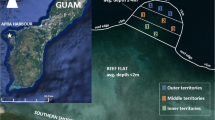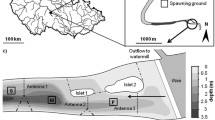Summary
-
1.
The mating system and seasonal patterns of behaviour of the protogynous wrasse Pseudolabrus celidotus were studied for 2 years in a shallow reef habitat in north-eastern New Zealand, with the purpose of determining how site-specific spawning by females influences the behaviour and spawning success of terminal phase (TP) males.
-
2.
Females were home ranging but made temporary trips into deeper areas during the breeding season solely for the purpose of spawning. Most TP males defended territories from other TP males, but nonterritorial, wide-ranging males commonly moved through the study area in the spaces between territories. The number of territories was highly variable, with only certain deeper sites being occupied consistently. Home ranges overlapped considerably with each other and with territories, but females were never actively confined to their ranges by TP males.
-
3.
Spawning success of TP males was not related to body size, age, coloration, or territory size. Successful males were generally resident for longer periods, spent more time swimming, courting and behaving aggressively towards initial phase (IP) fish, and less time feeding during the spawning season. Testis weight: body weight ratios were positively correlated with spawning success. Spawning rate increased exponentially with the depth of the territory and was highest on territories with large patches of shelter centred on bare rock areas.
-
4.
Experimental removal of TP males established that females were choosing particular sites to spawn at, and spawned only with TP males possessing these sites. Females presumably chose to spawn deep because egg-eating planktivorous fish were more abundant in shallow areas. The restriction of spawnings to areas adjacent to shelter sites suggests that females were vulnerable to predators during the spawning act.
-
5.
The mating system is classified as ‘resource defence polygyny’ (Emlen and Oring 1977) since TP males defending preferred spawning sites accounted for the large majority of the spawnings. The influence of spawning-site selection on the territorial system is discussed.
Similar content being viewed by others
References
Barlow GW (1975) On the sociobiology of some hermaphroditic serranid fishes, the Hamlets, in Puerto Rico. Mar Biol 33:295–300
Best LB (1977) Territory quality and mating success in the field sparrow (Spizella pusilla). Condor 79:192–204
Black R (1971) Hatching success in the three-spined stickleback (Gasterosteus aculeatus) in relation to changes in behaviour during the parental phase. Anim Behav 19:532–541
Brown JL (1975) The evolution of behavior. Norton, New York, p 761
Brown J, Green JM (1976) Territoriality, habitat selection, and prior residency in underyearling Stichaeus punctatus (Pisces: Stichaeidae). Can J Zool 54:1904–1907
Choat JH, Robertson DR (1975) Protogynous hermaphroditism in fishes of the family Scaridae. In: Reinboth R (ed) Intersexuality in the animal kingdom. Springer, Berlin Heidelberg New York, pp 263–283
Colin PL (1978) Daily and summer-winter variation in mass spawning of the striped parrotfish, Scarus croicensis. Fish Bull USA 76:117–124
Davies NB (1978) Ecological questions about territorial behaviour. In: Krebs J, Davies N (eds) Behavioural ecology: an evolutionary approach. Blackwell, Oxford, pp 317–350
Downhower JF, Brown L (1980) Mate preferences of female mottled sculpins Cottus bairdi. Anim Behav 28:728–734
Emlen ST, Oring LW (1977) Ecology, sexual selection and the evolution of mating systems. Science 197:215–223
Fischer EA (1980) The relationship between mating system and simultaneous hermaphroditism in the coral reef fish, Hypoplectrus nigricans (Serranidae). Anim Behav 28:620–633
Ghiselin MT (1969) The evolution of hermaphroditism among animals. Q Rev Biol 44:189–208
Hobson ES (1965) Diuranal-nocturnal activity of some inshore fishes in the Gulf of California. Copeia 1965:291–302
Howard RD (1978) The evolution of mating strategies in bullfrogs, Rana catesbeiana. Evolution 32:850–871
Jones GP (1980) Growth and reproduction in the protogynous hermaphrodite Pseudolabrus celidotus (Pisces: Labridae) in New Zealand. Copeia 1980:660–675
Jones GP, Thompson SM (1980) Social inhibition of maturation in females of the temperate wrasse Pseudolabrus celidotus and a comparison with the blennioid Tripterygion varium. Mar Biol 59:247–256
Kodric-Brown A (1977) Reproductive success and the evolution of breeding territories in pupfish (Cyprinodon). Evolution 31:750–766
Lenington S (1980) Female choice and polygyny in redwinged blackbirds. Anim Behav 28:347–361
Lobel PS (1978) Diel, lunar, and seasonal periodicity in the reproductive behavior of the pomacanthid fish, Centropyge potteri, and some other reef fishes in Hawaii. Pac Sci 32:193–207
Nitchuk WM, Evans RM (1978) A volumetric analysis of sharptailed grouse sperm in relation to dancing ground size and organization. Wilson Bull 90:460–462
Odum EP, Kuenzler EJ (1955) Measurement of territory and home range size in birds. Auk 72:128–137
Perrone M (1978) Mate size and breeding success in a monogamous cichlid fish. Environ Biol Fishes 3:193–201
Randall JE, Randall HA (1963) The spawning and early development of the Atlantic parrotfish Sparisoma rubripinne, with notes on other scarid and labrid fishes. Zoologica 48:49–60
Robertson DR (1972) Social control of sex reversal in a coral-reef fish. Science 177:1007–1009
Robertson DR, Choat JH (1974) Protogynous hermaphroditism and social systems in labrid fishes. In: Proceedings of the second international symposium on coral reefs, G.B.R.C. Brisbane 1:217–225
Robertson DR, Hoffman SG (1977) The roles of female mate choice and predation in the mating systems of some tropical fishes. Z Tierpsychol 45:298–320
Ryan MJ (1980) Female mate choice in a neotropical frog. Science 209:523–525
Sale PF (1978) Co-existence of coral reef fishes—a lottery for living space. Environ Biol Fishes 3:85–102
Schmale MC (1980) A preliminary report on sexual selection in the bicolor damselfish, Euromacentrus partitus. Bull Mar Sci 30:328
Searcy WA (1979) Female choice of mates: A general model for birds and its application to red-winged blackbirds (Agelaius phoeniceus). Am Nat 114:77–100
Thresher RE (1979) Social behavior and ecology of two sympatric wrasses (Labridae: Halichoeres spp.) off the coast of Florida. Mar Biol 53:161–172
Warner RR (1975) The adaptive significance of sequential hermaphroditism in animals. Am Nat 109:61–82
Warner RR, Robertson DR and Leigh EG (1975) Sex change and sexual selection. Science 190:633–638
Wells KD (1977) Territoriality and male mating success in the green frog (Rana clamitans). Ecology 58:750–762
Author information
Authors and Affiliations
Rights and permissions
About this article
Cite this article
Jones, G.P. Spawning-site choice by female Pseudolabrus celidotus (Pisces: Labridae) and its influence on the mating system. Behav Ecol Sociobiol 8, 129–142 (1981). https://doi.org/10.1007/BF00300825
Received:
Accepted:
Issue Date:
DOI: https://doi.org/10.1007/BF00300825




